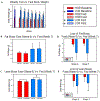Differential weight loss with intermittent fasting or daily calorie restriction in low- and high-fitness phenotypes
- PMID: 34086376
- PMCID: PMC8324547
- DOI: 10.1113/EP089434
Differential weight loss with intermittent fasting or daily calorie restriction in low- and high-fitness phenotypes
Abstract
New findings: What is the central question of this study? How does intrinsic aerobic capacity impact weight loss with 50% daily caloric restriction and alternate-day fasting? What is the main finding and its importance? Intermittent fasting is effective for weight loss in rats with low fitness, which highlights the importance of how intermittent fasting interacts with aerobic fitness.
Abstract: Recent interest has focused on the benefits of time-restricted feeding strategies, including intermittent fasting, for weight loss. It is not yet known whether intermittent fasting is more effective than daily caloric restriction at stimulating weight loss and how each is subject to individual differences. Here, rat models of leanness and obesity, artificially selected for intrinsically high (HCR) and low (LCR) aerobic capacity, were subjected to intermittent fasting and 50% calorie restrictive diets in two separate experiments using male rats. The lean, high-fitness HCR and obesity-prone, low-fitness LCR rats underwent 50% caloric restriction while body weight and composition were monitored. The low-fitness LCR rats were better able to retain lean mass than the high-fitness HCR rats, without significantly different proportional loss of weight or fat. In a separate experiment using intermittent fasting in male HCR and LCR rats, alternate-day fasting induced significantly greater loss of weight and fat mass in LCR compared with HCR rats, although the HCR rats had a more marked reduction in ad libitum daily food intake. Altogether, this suggests that intermittent fasting is an effective weight-loss strategy for those with low intrinsic aerobic fitness; however, direct comparison of caloric restriction and intermittent fasting is warranted to determine any differential effects on energy expenditure in lean and obesity-prone phenotypes.
Keywords: adiposity; alternate-day fasting; body composition; high- and low-capacity runners; intrinsic aerobic capacity; male; rat.
© 2021 The Authors. Experimental Physiology © 2021 The Physiological Society.
Conflict of interest statement
Competing Interests
Authors have no competing interests in regard to data presented in this manuscript.
Figures





Similar articles
-
Enhanced weight and fat loss from long-term intermittent fasting in obesity-prone, low-fitness rats.Physiol Behav. 2021 Mar 1;230:113280. doi: 10.1016/j.physbeh.2020.113280. Epub 2020 Dec 5. Physiol Behav. 2021. PMID: 33285179 Free PMC article.
-
Physically active rats lose more weight during calorie restriction.Physiol Behav. 2015 Feb;139:303-13. doi: 10.1016/j.physbeh.2014.11.044. Epub 2014 Nov 20. Physiol Behav. 2015. PMID: 25449411 Free PMC article.
-
Aerobic capacity modulates adaptive thermogenesis: Contribution of non-resting energy expenditure.Physiol Behav. 2020 Oct 15;225:113048. doi: 10.1016/j.physbeh.2020.113048. Epub 2020 Jul 3. Physiol Behav. 2020. PMID: 32628949 Free PMC article.
-
Intermittent versus daily calorie restriction: which diet regimen is more effective for weight loss?Obes Rev. 2011 Jul;12(7):e593-601. doi: 10.1111/j.1467-789X.2011.00873.x. Epub 2011 Mar 17. Obes Rev. 2011. PMID: 21410865 Review.
-
Fasting for weight loss: an effective strategy or latest dieting trend?Int J Obes (Lond). 2015 May;39(5):727-33. doi: 10.1038/ijo.2014.214. Epub 2014 Dec 26. Int J Obes (Lond). 2015. PMID: 25540982 Review.
Cited by
-
Intrinsic cardiorespiratory fitness modulates clinical and molecular response to caloric restriction.Mol Metab. 2023 Feb;68:101668. doi: 10.1016/j.molmet.2023.101668. Epub 2023 Jan 12. Mol Metab. 2023. PMID: 36642218 Free PMC article.
References
-
- Beaulieu K, Casanova N, Oustric P, Hopkins M, Varady K, Finlayson G, & Gibbons C (2020). An exploratory investigation of the impact of ‘fast’ and ‘feed’ days during intermittent energy restriction on free-living energy balance behaviours and subjective states in women with overweight/obesity. Eur J Clin Nutr. doi:10.1038/s41430-020-00740-1 - DOI - PubMed

